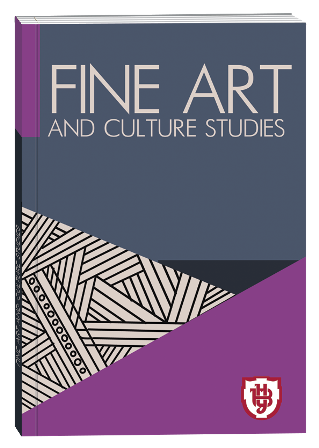NATIONAL IMAGE OF THE PIANO
DOI:
https://doi.org/10.32782/facs-2023-3-1Keywords:
sound image of the instrument, national image of the instrument, national image of the piano, civilizational image of the piano, jazz piano, Burmese sandaya piano, Iranian (Persian) piano.Abstract
The aspiration of modern musicology to penetrate as deeply as possible into the essence of the processes of creation, performance and perception of musical works caused the introduction into scientific and critical circulation of the concept of "sound image of an instrument", specifically the piano. The article puts forward and analyzes the hypothesis about the existence of different national images of the piano, which should be considered in the context of the national image of the world. The purpose of the work is to define and introduce the concept of "national image of the piano" into scientific circulation. The research methodology is based on a cultural approach, which was used to identify the image of the piano as a symbol of high culture and European civilization, and a systematic analysis, which was used to define the concept of "national image of the piano". The scientific novelty of the research lies in the fact that it first formulated the concept of the national image of the piano, defined the conditions and mechanisms of its formation. The cultural phenomena of the Burmese "sandaya" piano and the "Iranian (Persian) piano" were also taken into consideration for the first time in Ukrainian musicology. Conclusions. Such phenomena of world musical culture as jazz piano, Burmese "sandaya" piano, Iranian (Persian) piano confirm the hypothesis of the existence of different national images of the piano. By "national image" of a musical instrument, we mean the outcome of the reconstruction of this musical instrument in the mind of the subject of the musical process (composer, performer, listener), dictated by variables unique to a certain national community. The transnational universal instrument and its expressive powers are modified by the national musical culture during the creation of the national image of the piano, which then becomes the embodiment of the national image of the world in music. The significance of the piano's place in social and cultural life, the development of a national piano style, and a timbre-colouring that can be identified as being uniquely national are the major components of the national image of the piano.
References
Артеменко В.М. Національний образ світу та питання стилеутворення в російському симфонізмі 60– 70-х років ХІХ століття : автореф. дис. … канд. мистецтвознавства : 17.00.03. Київ, 2007. 20 с.
Корзун В.В. Особливості підходу до усвідомлення нового звукового образу фортепіано в творах сучасних композиторів. Наукові записки Національного педагогічного університету імені М. П. Драгоманова. 2011. Вип. 96. С. 110–116.
Костогриз С.О. Виконавство на балалайці Харківщини як складова українського музичного мистецтва : дис. … канд. мистецтвознавства : 17.00.03. Харків, 2017. 254 с.
Кучма Н.А. Втілення звукового образу фортепіано в циклах етюдів композиторів ХІХ–ХХ століть : дис. … д‑ра філос : 025 − Музичне мистецтво. Харків, 2021. 201 с.
Кушнірук О. Рефлексія національного в музичному дискурсі. Студії мистецтвознавчі: Театр. Музика. Кіно. 2009. Число 4 (28). С. 44–47.
Лю Фань. Гендерний образ фортепіано. Мистецтвознавчі записки. 2017. № 32. С. 382–390.
Лю Фань. Соціально-культурні чинники становлення образа фортепіано. Міжнародний вісник: Культурологія. Філологія. Музикознавство. 2017. Вип. ІІ (9). С. 219–224.
Лю Фань. Старий сучасний погляд на фортепіано у творчості Ігоря Щербакова. Музикознавча думка Дніпропетровщини. 2017. Вип. 13. С. 38–49.
Матвіїв Г.В. Звукообразні чинники сучасної бандурної творчості: інструментально-виконавський авторський підхід : дис. … канд. мистецтвознавства : 17.00.03. Одеса, 2021. 190 с.
Ревенко Н.В. Фортепіанна творчість українських композиторів у контексті розвитку музичної культури України (80–90-і роки ХХ століття) : автореф. дис. … канд. мистецтвознавства : 17.00.01. Київ, 2004. 22 с.
Рябуха Н.О. Трансформація звукового образу світу в фортепіанній культурі: онто-сонологічний підхід : дис. … д-ра мистецтвознавства : 26.00.01. Харків, 2017. 456 с.
Самойленко О. Наукові обрії сучасного українського музикознавства Мистецтвознавство України. 2010. Вип. 11. С. 38–45.
Bezborodko O. Innovative use of the damper pedal in the contemporary piano music. Вісник Національної академії керівних кадрів культури і мистецтв. 2017. № 3. С. 89–94.
Farshadfar M. The practice of Persian piano in Iran from 1879 to 1979 : thèse présentée … Docteur en ethnomusicology (Ph.D.). Montreal, 2017. xiv, 304 p.
Garfias R. Tonal structure in Burmese music as exemplified in the piano music of U Ko Ko. Ethnomusicology OnLine. 1995. No. 1. URL: https://www.umbc.edu/eol/garfias/burma1.html (дата звернення: 25.07.2023).
Loesser A. Men, women & pianos : a social history / preface by Jacques Barzun. New York : Dover Publications, 2011. xviii, 655 p.
Parakilas J. Piano roles : three hundred years of life with the piano. – New Haven & London : Yale University Press, 2001. 391 p.
Slonimsky N. Slonimsky’s book of musical anecdotes. New York, London : Routledge, 2002. 307 p.
Webster J. Solitude and Sandaya: the strange history of pianos in Burma / The Appendix : a new journal of narrative and experimental history. 2013. Vol. 1, issue 3 : Out Loud. P. 61–66.
Young K. The strange, the familiar: foreign musical instruments in Myanmar/Burma / Asia Society. URL: https://asiasociety.org/strange-familiar-foreign-musical-instruments-myanmarburma (дата звернення: 25.07.2023).







